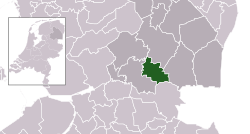Hoogeveen
Hoogeveen | |
|---|---|
 Former court house in Hoogeveen | |
 Location in Drenthe | |
| Country | Netherlands |
| Province | Drenthe |
| Government | |
| • Body | Municipal council |
| • Mayor | Karel Loohuis (PvdA) |
| Area | |
| • Total | 129.25 km2 (49.90 sq mi) |
| • Land | 127.54 km2 (49.24 sq mi) |
| • Water | 1.71 km2 (0.66 sq mi) |
| Elevation | 12 m (39 ft) |
| Population (January 2021)[4] | |
| • Total | 55,603 |
| • Density | 436/km2 (1,130/sq mi) |
| Demonym | Hoogevener |
| Time zone | UTC+1 (CET) |
| • Summer (DST) | UTC+2 (CEST) |
| Postcode | Parts of 7900 range |
| Area code | 0524, 0528 |
| Website | www |
Hoogeveen [ˌɦoːɣəˈveːn] (Dutch Low Saxon: 't Ogeveine or 't Oveine) is a municipality and a town in the northeastern Netherlands.
Population centres

Elim, Fluitenberg, Hoogeveen and Noordscheschut, which still have the canals which used to be throughout the town. Other villages of the town are Hollandscheveld, Nieuw Moscou, Nieuweroord, Nieuwlande, Pesse, Stuifzand and Tiendeveen.
Hoogeveen

It dates its history to 20 December 1625, when Roelof van Echten bought a large tract of peat land from farmers of the district with the plan to harvest its peat. One old map of the area called it Locus Deserta Atque ob Multos Paludes Invia, a deserted and impenetrable place of many swamps. Hoogeveen itself was established in 1636 by Peter Joostens Warmont and Johan van der Meer.
Its coat of arms, granted 10 November 1819, is white, with a pile of peat covered in straw in the center and beehives on each side, representing the town's first two major industries.

Vincent van Gogh visited the area in the fall of 1883.[5]
In the second half of the 1960s, Hoogeveen was the fastest growing town in the Netherlands. Its rapid growth during that period led its city council to fill most of the town's canals, canals dug in the area's early days when it was a prime source of peat.
Access to the town is provided by the A28 (Utrecht - Groningen) highway, the N/A37 (Hoogeveen - Germany), and the Western Cities - Groningen railway.
The then recognized oldest person in the world, Hendrikje van Andel-Schipper, lived in Hoogeveen until her death in August 2005.
Hoogeveen also has a small airport that attracts some tourism. Since 1997 the Hoogeveen Chess Tournament is organized.
Transport
Railway Station: Hoogeveen
International relations
Twin towns — Sister cities
Hoogeveen is twinned with:
Notable people
- Jens Jurn Streutker, footballer
- Iwan van der Vinne, footballer and member in the order of Oranje-Nassau
- Vivianne Miedema, footballer
References
Footnotes
- ^ "De leden van het college" (in Dutch). Gemeente Hoogeveen. Retrieved 7 October 2013.
{{cite web}}: Unknown parameter|trans_title=ignored (|trans-title=suggested) (help) - ^ "Kerncijfers wijken en buurten 2020" [Key figures for neighbourhoods 2020]. StatLine (in Dutch). CBS. 24 July 2020. Retrieved 19 September 2020.
- ^ "Postcodetool for 7901BW". Actueel Hoogtebestand Nederland (in Dutch). Het Waterschapshuis. Retrieved 7 October 2013.
{{cite web}}: Cite has empty unknown parameter:|trans_title=(help) - ^ "Bevolkingsontwikkeling; regio per maand" [Population growth; regions per month]. CBS Statline (in Dutch). CBS. 1 January 2021. Retrieved 2 January 2022.
- ^ Dead link to The New Yorker
Bibliography
- Dijk, Wout J., & van der Sluis, Meent W.: De Drentse tijd van Vincent van Gogh, Boon uitgeverij, Groningen 2001 ISBN 90-75913-18-4


